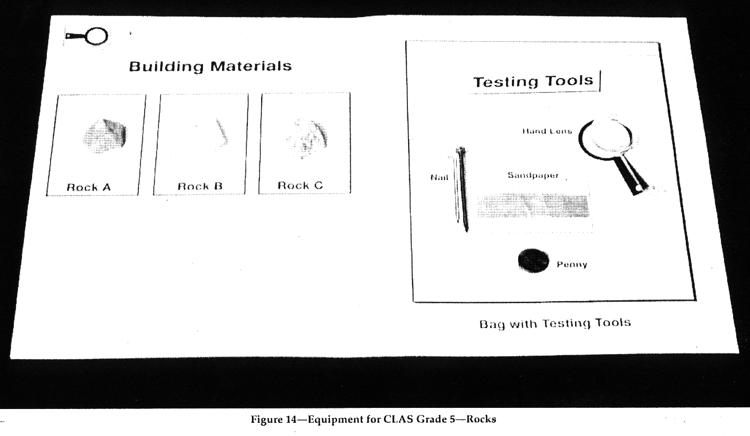5th Grade Performance Task
Contributed by: The RAND Institute (RAND)
Spring 1993 Research Pilot
Description:
Students are presented with three rocks and a variety of tools
and are asked to investigate the properties of the rocks to see
which rock will be best for building tables and benches for a museum
picnic area. The task assesses students' abilities to design an
investigation, make simple observations, make generalized inferences
from their observations, and apply their understanding.
This task is designed to take students approximately 10-15 minutes
to complete.
Overall Task Content Area:
- Earth/Space Science
Specific Knowledge Areas:
- Rocks and Erosion
Performance Expectations:
- conducting investigations
- using equipment
- gathering, organizing, and representing data
- formulating conclusions from investigational data
- applying scientific principles to develop explanations and solve
new problems
National Science Education Standards:
4 D ESS 1: Properties of earth materials: Grades K-4
1.1 Earth materials are solid rocks and soils, water, and
the gases of the atmosphere. The varied materials have different
physical and chemical properties, which make them useful in different
ways, for example, as building materials, as sources of fuel, or
for growing the plants we use as food. Earth materials provide many
of the resources that humans use.
8 A SI 1: Abilities necessary to do scientific inquiry:
Grades 5-8
1.4 Develop descriptions, explanations, predictions, and
models using evidence. Students should base their explanation on
what they observed, and as they develop cognitive skills, they should
be able to differentiate explanation from description — providing
causes for effects and establishing relationships based on evidence
and logical argument. This standards requires a subject knowledge
base so the students can effectively conduct investigations, because
developing explanations establishes connections between the content
of science and the contexts within which students develop new knowledge.
1.8 Use mathematics in all aspects of scientific inquiry.
Mathematics is essential to asking and answering questions about
the natural world. Mathematics can be used to ask questions; to
gather, organize, and present data; and to structure convincing
explanations.
(Use the "hot" link on the PALS home page
to check the full text of related National Science Education Standards,
if desired.)
National Council of Teachers of Mathematics:
AL1: Understand patterns, relations and functions:
Grades 6-8 f. represent, analyze, and generalize a variety
of patterns with tables, graphs, words, and, when possible, symbolic
rules
DAP3: Develop and evaluate inferences
and predictions that are based on data:
Grades 6-8 c. use observations about differences
between two or more samples to make conjectures about the populations
from which the samples were taken
PS2: Solve problems that arise in mathematics and in
other contexts:
Grades 6-8
This task is designed to take students approximately 10-15 minutes
to complete.
Students will be working individually during this exercise.
Students should be ready to work as soon as the period begins.
The materials should be set out at each lab station, if possible.
A central supply area, if needed, should be easily accessible. All
supplies should be clearly labeled.
Materials for "Building Materials":
At this station students should have:
- A small sample of three different types of rock labeled A,
B, and C
- A plastic bag labeled Bag #1 containing
- a hand lens
- a nail
- a small scrap of sand paper
- a penny
Advance Preparation:
- Label rocks with a sticker as "A," "B," and "C."
- Appropriate tools into small plastic bags labeled "Bag #1."
Safety:
- Caution children while handling sharp objects such as the nail
in Bag #1.
- Be careful.
- Teachers and students should always exercise appropriate safety
precautions and utilize appropriate laboratory safety procedures
and equipment when working on science performance tasks.
Extensions/modifications:
- Building Materials was designed as a portion of a three part
performance assessment to be given concurrently. The other two
portions aligned with Building Materials are "Which Road?" and
"Critter Museum."

|


